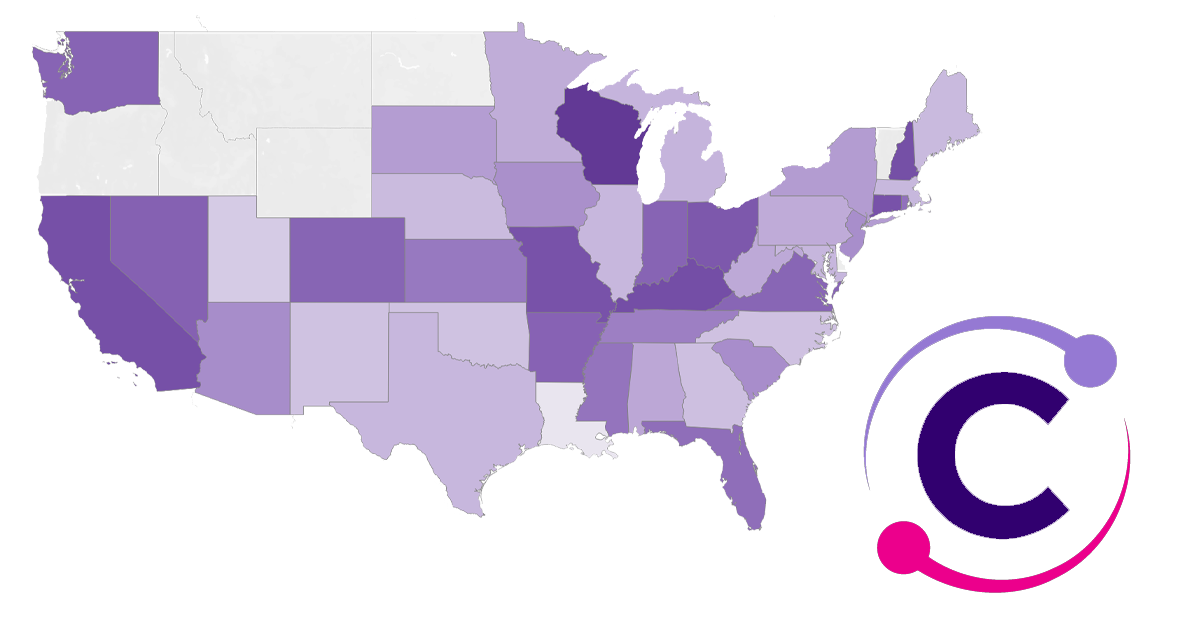What if the healthcare industry could predict the future … the outcome of interventions, the onset of preventable and chronic conditions, or the spread of pandemic? How valuable would that be? All we need to unlock that predictive power is access to the right data.
To make informed decisions in times of crisis, policymakers and community leaders need access to timely, relevant, and accurate information. Throughout the COVID-19 pandemic, widespread shortages of testing resources have deprived decision-makers of the data they need to monitor and respond to the rapid spread of novel coronavirus. To address this challenge, Cotiviti developed a solution that would overcome the shortage of COVID-19 tests by searching for leading indicators of hidden outbreak in the most complete, enriched longitudinal healthcare data reserve in the United States—Caspian Insights.
Visit Cotiviti's new Healthcare Payer Resource Center for more information on how payers can mitigate the impact of COVID-19.
On March 12, when the United States had less than 1,700 confirmed cases of COVID-19, Cotiviti analyzed Caspian data and identified 23 states with leading indicators of community spread and potentially unconfirmed outbreak. Two weeks later, the U.S. had over 80,000 confirmed cases—and all of the states forecasted by Cotiviti to have outbreaks were at the top of the list of confirmed cases.
Cotiviti responds to the pandemic
In late 2019, a novel coronavirus was quietly spreading in Wuhan, China. Growing reports of a severe, viral pneumonia outbreak soon attracted attention from around the world. By January, the first confirmed cases of COVID-19 had surfaced internationally in Thailand and in the United States. By February, COVID-19 outbreaks had emerged in South Korea, France, Iran, and Italy. The United States declared a state of emergency on February 29, and on March 11, the World Health Organization declared a pandemic.
That same day, Cotiviti mobilized a pandemic response team. To aid in the response, Cotiviti deployed its Caspian Insights data and analytics platform to power a public health surveillance capability for COVID-19.
During the early stages of the pandemic, COVID-19 tests were not widely available in the United States, and any available tests were reserved for those most vulnerable to complications from the virus. Patients with fever, dry cough, difficulty breathing, and other flu-like symptoms were triaged and screened to route those less at risk and the “worried well” away from scarce testing resources. Since most cases of COVID-19 are asymptomatic or have only mild symptoms, these screening practices left the nation blind to the true magnitude and severity of community spread.
As these rationing patterns continued, health experts expressed mounting concern that the lack of widespread surveillance testing could result in rapidly growing populations of unconfirmed cases, leaving countless carriers of COVID-19 circulating in society, transmitting the contagion to others. Epidemiologists knew from recent experience in Italy and China that these blind spots of hidden outbreak would eventually emerge as an overwhelming surge of severe and fatal cases.
In February, the CDC attempted to use flu surveillance testing to identify potentially hidden outbreaks of COVID-19; however, the agency was unable to fully utilize the flu surveillance network due to lack of sufficient data from participating sites. After observing these trends, the pandemic response team at Cotiviti posed a question, “Can we use Caspian data available to us for research to find unconfirmed cases that could lead to hidden outbreak?”
Caspian data provides predictive power
The Cotiviti team immediately began research into COVID-19 and consulted with clinicians to gain an understanding of the basics of epidemiology. They explored forecasting models such as the S.I.R. and S.E.I.R. models, which track and forecast epidemiological trends based on portions of a population that are Susceptible, Exposed, Infected, or Recovered. The primary measure of transmissibility, R0 (pronounced R-naught), became an early focus in efforts to forecast more accurately by dynamically adjusting the R0 based on other contributing factors such as climate, population density, and land coverage. With broad insight into the historical inpatient demand on the supply of intensive care resources across the nation, Cotiviti is uniquely positioned to predict the true impact of the S.I.R. curve on available healthcare capacity.
While S.I.R. modeling enhanced with applicable Caspian data looked promising, the world had already turned significant attention to these models and the critical message to flatten the curve. The pandemic response team at Cotiviti continued to search for an even more impactful contribution that could only be provided through unique insights from Caspian data. Ultimately, the team zeroed in on pattern recognition and anomaly detection, based on a growing understanding of the signature care profile of COVID-19, a unique, syndromic pattern of care that can be seen in the emerging and historical claim, clinical, Rx, and lab data of a patient.
Each patient who is eventually diagnosed with severe complications of COVID-19 while in intensive care has progressed through a series of tests, procedures, diagnoses, and pharmaceutical interventions. While these patterns are complex, machine learning models can be trained with historical labeled data to recognize and classify these COVID-like syndromic cases as they emerge and progress. The Caspian Insights platform collects and connects data made available for research from multiple sources to create a rich historical view of patient health and care. This longitudinal patient record is a unique and critical input that is necessary to identify and track the onset of medical conditions over multiple episodes of care.
Figure 1. The signature care profile of COVID-19 (click to enlarge).
As the Cotiviti pandemic response team studied the signature care profile of COVID-19, they also identified an initial care pattern that proved most useful in providing early warning surveillance of potential COVID-19 cases. The early screening and triage procedures follow a very simple and visible process that provides leading indicators of a potential spike in unconfirmed cases of COVID-19. This pattern, which includes triage routing to screening procedures such as telemedicine, rapid flu test, and chest x-ray, can be clearly seen in the data derived from the millions of medical claims that Cotiviti processes from all fifty states on a daily basis.
Figure 2. The initial care pattern of COVID-19 (click to enlarge).
Cotiviti’s forecasting methodology
As the team examined these leading indicators, they found that patterns of flu testing and diagnosis provide the best window into populations of unconfirmed COVID-19 patients who exhibit flu-like symptoms. Seasonal flu trends follow a wave pattern that is distinct for each geographic region, but remains fairly consistent within a region year over year. Local flu trends vary based on weather patterns, the emergence of unidentified flu strains, and population density, but there are consistent correlations between normal trends in rapid flu tests and flu diagnosis. Any disruption to these trends is an anomaly that could be caused by an outbreak of COVID-19.
Figure 3. Flu swab testing versus flu diagnosis trends (click to enlarge).
With this research, Cotiviti analyzed data from recent and historical claims to detect time-series anomalies in the rate, volume, and ratio of ICD-10 and CPT codes that represent flu testing procedures and flu diagnosis. Using these codes and provider zip codes as an input, the team applied signal processing algorithms to reveal geographic areas with anomalous trends in care for infectious upper respiratory disease, indicating regions at risk of potentially hidden outbreak.
.png?width=920&name=Cotiviti_COVID19%20(4).png)
Figure 4. Time-series anomaly detection across the United States.
Eighty percent of the predictions made on March 12 using these methods were realized by March 22. The team has continued to use Caspian data to make accurate predictions each week and moved quickly to make these insights publicly available to provide crucial information to leaders and decision makers as they continue their pandemic response.
.png?width=920&name=Cotiviti_COVID19%20(5).png)
Figure 5. Comparison of Cotiviti anomaly forecast on March 12 to NYT confirmed cases on March 22.
Key takeaways for all healthcare stakeholders
Cotiviti forecasts provide early warning of potentially hidden outbreak. Leaders, decision-makers, and the general public can now view these forecasts online using Cotiviti’s publicly available COVID-19 Outbreak Tracker.
Pandemic trends in the United States should not be directly compared to trends in other countries, and the national curve should not be viewed as a uniform representation of the pandemic across the nation. The United States is the third largest country in both population and land mass. Even though many states are now observing a decline in confirmed cases, each state should be viewed as an independent epidemic and can experience a unique epidemic curve with varying degrees of severity and impact, much like the individual countries throughout Europe. Confirmed and hidden outbreaks may continue to emerge in different states and may also return in waves.
As the pandemic progresses, Cotiviti forecasts will provide informative and actionable insights to all Americans. The most important insight is the ongoing need to practice social distancing when directed to do so by community leaders. Even if a state or city does not have a high number of confirmed cases, Cotiviti’s work has shown that the true magnitude and severity of the outbreak can be much higher than we are able to see through COVID-19 testing. Accordingly, the CDC will be looking for 14-day downward trends of influenza-like illness (ILI) and COVID-like syndromic cases as leading indicators to determine when individual states can begin moving through the phases of lifting lockdown restrictions. The virus can continue to spread, resurge, and threaten to overwhelm our healthcare system until it has burned through the susceptible population or until we succeed in flattening the curve. All Americans must do their part to flatten the curve by staying at home during lockdown, by strictly following instructions for each phase of lifting lockdown, and by making habits of good hygiene and wellness guidelines as critical best practices for individual and public health.
For more resources, visit Cotiviti’s COVID-19 Resource Center to keep up with the latest pandemic news and its impact.



.png?width=920&name=Cotiviti_COVID19%20(1).png)
.png?width=920&name=Cotiviti_COVID19%20(2).png)
.png?width=920&name=Cotiviti_COVID19%20(3).png)


